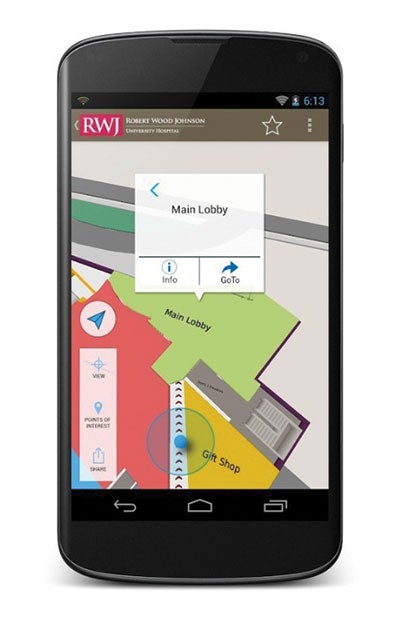Application offers hospital visitors precise directions
 |
| A new wayfinding app developed for Robert Wood Johnson University Hospital provides users with true turn-by-turn directions inside the facility. |
Robert Wood Johnson University Hospital (RWJUH), New Brunswick, N.J., has launched a precise turn-by-turn indoor navigation mobile application for use by patients, visitors and staff with smartphones.
MediNav Navigator Edition 2.0 is an advanced indoor navigation app, developed by Connexient Inc., New York City.
It also offers true turn-by-turn indoor navigation with camera positioning driven by location and direction, dynamic navigation prompts with visual landmark references and more.
The RWJ Find Your Way app gives a menu of popular destinations, such as restrooms or the dining room, plus a search feature to help users find their destination. The app can identify where the user is within the hospital, and links up with digital signage located throughout the hospital as an additional wayfinding aid.
“The launch of MediNav is the first step in a journey to use indoor navigation and location-based services to benefit all of the stakeholders at RWJUH,” says Joanne Arico, R.N., director of patient experience.
“Our focus for 2015 is to enhance our patient experience, as well as improve staff efficiency and prevent late and missed appointments,” she says.
The app can be downloaded on the App Store and Google Play as the RWJUH Find Your Way Mobile Application. In addition, RWJUH has deployed MediNav iPad kiosks in its lobby and has added a website version of the app.
Mark Green, CEO and co-founder of Connexient, explains that the first of two key components to the app and wayfinding system involves developing the indoor mapping, which the company creates through the use of AutoCAD files of floor plans provided by the hospital. Green says the mapping has a “near 3-D” look and feel.
The next step in the process is to install Bluetooth low-energy beacons, which are business card-sized sensors, every 30 to 40 meters inside the hallways so that each one covers about 6,000 sq. ft. The beacons provide the technology to identify the hospital location of the person using the app, Green explains.
The app also provides a content management system that allows the user to pick his destination from a list of physicians, medical departments or room numbers provided by the hospital.
“The app will create this ‘fly-through’ navigational experience, so it shows you where you’re at and what’s coming up,” Green says.




